HSC318 - Rural and Remote Health Program Peer Review Report
VerifiedAdded on 2022/09/28
|7
|2033
|39
Report
AI Summary
This document presents a peer review of a mock grant submission for a rural and remote health program. The review assesses various aspects of the grant proposal, including the executive summary, key outcomes, community demographics, target group identification, stakeholder analysis, program activities, key performance indicators, funding allocation, and evaluation criteria. The reviewer provides detailed feedback on each section, highlighting strengths such as the identification of the target group and weaknesses such as the lack of a clear timeline for program activities and limitations in the funding allocation approach. The review also emphasizes the importance of incorporating limitations and ethical considerations in the report. The review is based on the provided grant review template and uses relevant research to support the feedback provided. The review concludes with a summary of the overall quality of the report and suggestions for improvement. The reviewer provides a comprehensive analysis of the grant proposal, identifying areas for improvement and offering constructive feedback based on best practices.
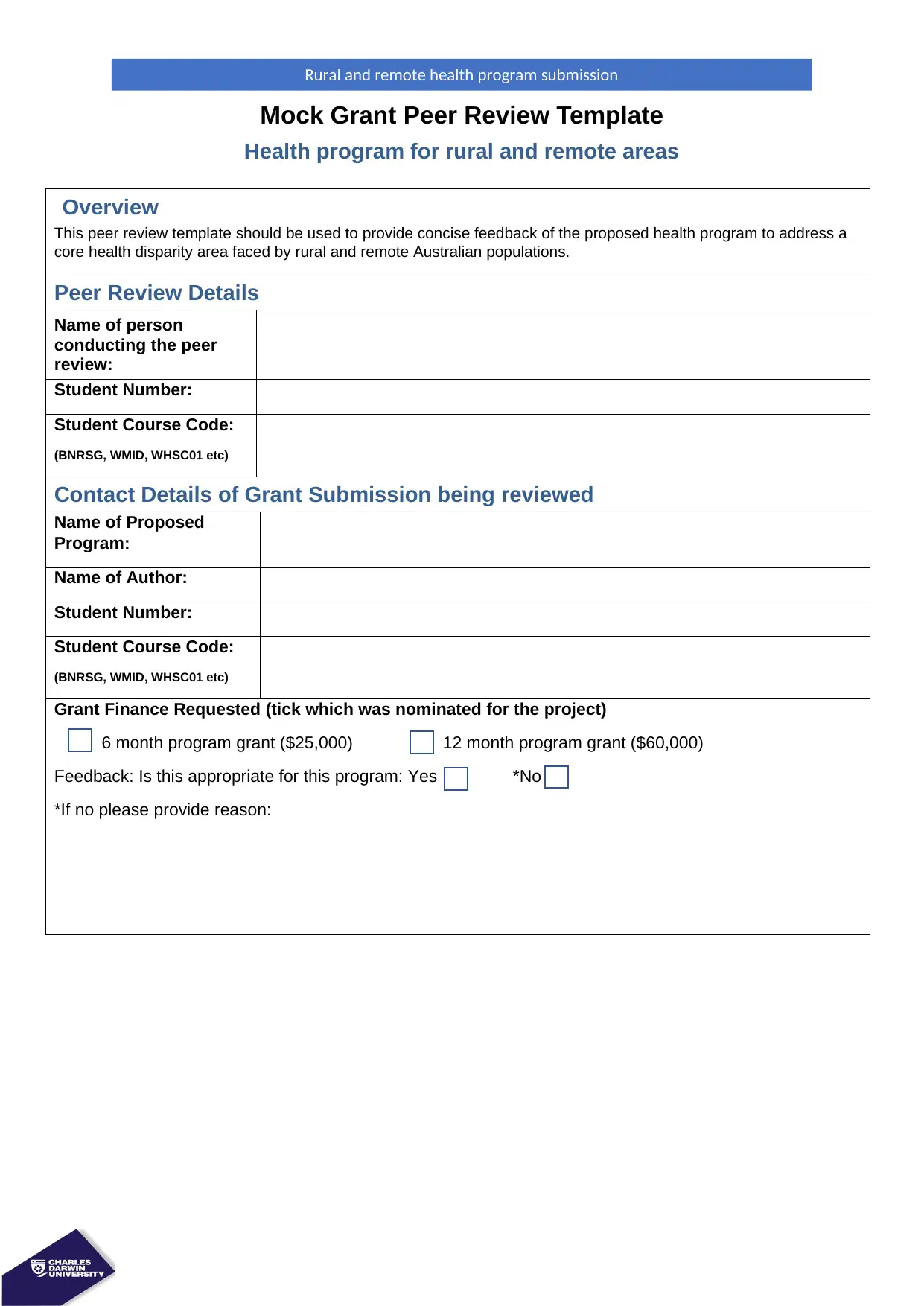
Mock Grant Peer Review Template
Health program for rural and remote areas
Overview
This peer review template should be used to provide concise feedback of the proposed health program to address a
core health disparity area faced by rural and remote Australian populations.
Peer Review Details
Name of person
conducting the peer
review:
Student Number:
Student Course Code:
(BNRSG, WMID, WHSC01 etc)
Contact Details of Grant Submission being reviewed
Name of Proposed
Program:
Name of Author:
Student Number:
Student Course Code:
(BNRSG, WMID, WHSC01 etc)
Grant Finance Requested (tick which was nominated for the project)
6 month program grant ($25,000) 12 month program grant ($60,000)
Feedback: Is this appropriate for this program: Yes *No
*If no please provide reason:
Rural and remote health program submission
Health program for rural and remote areas
Overview
This peer review template should be used to provide concise feedback of the proposed health program to address a
core health disparity area faced by rural and remote Australian populations.
Peer Review Details
Name of person
conducting the peer
review:
Student Number:
Student Course Code:
(BNRSG, WMID, WHSC01 etc)
Contact Details of Grant Submission being reviewed
Name of Proposed
Program:
Name of Author:
Student Number:
Student Course Code:
(BNRSG, WMID, WHSC01 etc)
Grant Finance Requested (tick which was nominated for the project)
6 month program grant ($25,000) 12 month program grant ($60,000)
Feedback: Is this appropriate for this program: Yes *No
*If no please provide reason:
Rural and remote health program submission
Paraphrase This Document
Need a fresh take? Get an instant paraphrase of this document with our AI Paraphraser
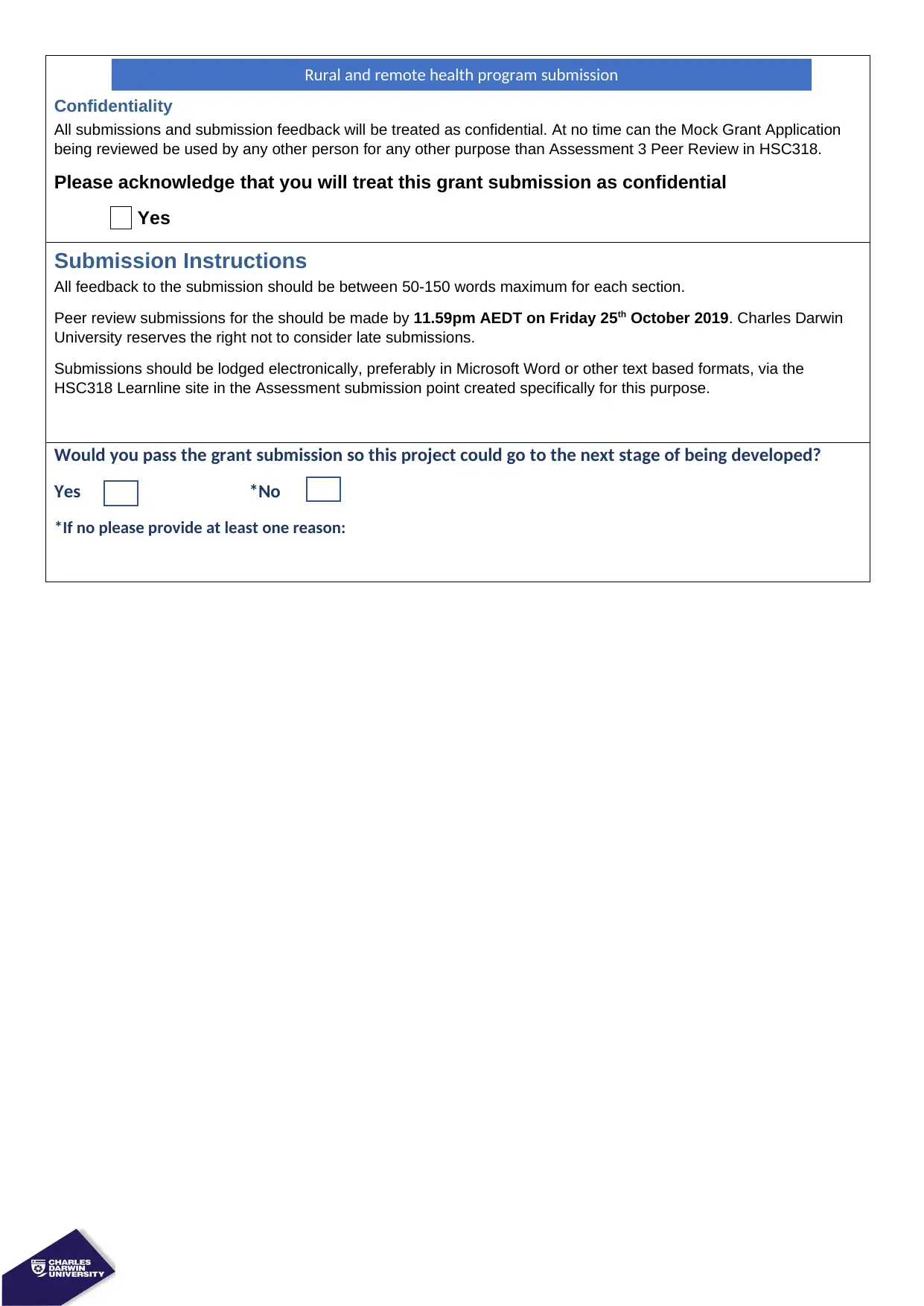
Confidentiality
All submissions and submission feedback will be treated as confidential. At no time can the Mock Grant Application
being reviewed be used by any other person for any other purpose than Assessment 3 Peer Review in HSC318.
Please acknowledge that you will treat this grant submission as confidential
Yes
Submission Instructions
All feedback to the submission should be between 50-150 words maximum for each section.
Peer review submissions for the should be made by 11.59pm AEDT on Friday 25th October 2019. Charles Darwin
University reserves the right not to consider late submissions.
Submissions should be lodged electronically, preferably in Microsoft Word or other text based formats, via the
HSC318 Learnline site in the Assessment submission point created specifically for this purpose.
Would you pass the grant submission so this project could go to the next stage of being developed?
Yes *No
*If no please provide at least one reason:
Rural and remote health program submission
All submissions and submission feedback will be treated as confidential. At no time can the Mock Grant Application
being reviewed be used by any other person for any other purpose than Assessment 3 Peer Review in HSC318.
Please acknowledge that you will treat this grant submission as confidential
Yes
Submission Instructions
All feedback to the submission should be between 50-150 words maximum for each section.
Peer review submissions for the should be made by 11.59pm AEDT on Friday 25th October 2019. Charles Darwin
University reserves the right not to consider late submissions.
Submissions should be lodged electronically, preferably in Microsoft Word or other text based formats, via the
HSC318 Learnline site in the Assessment submission point created specifically for this purpose.
Would you pass the grant submission so this project could go to the next stage of being developed?
Yes *No
*If no please provide at least one reason:
Rural and remote health program submission
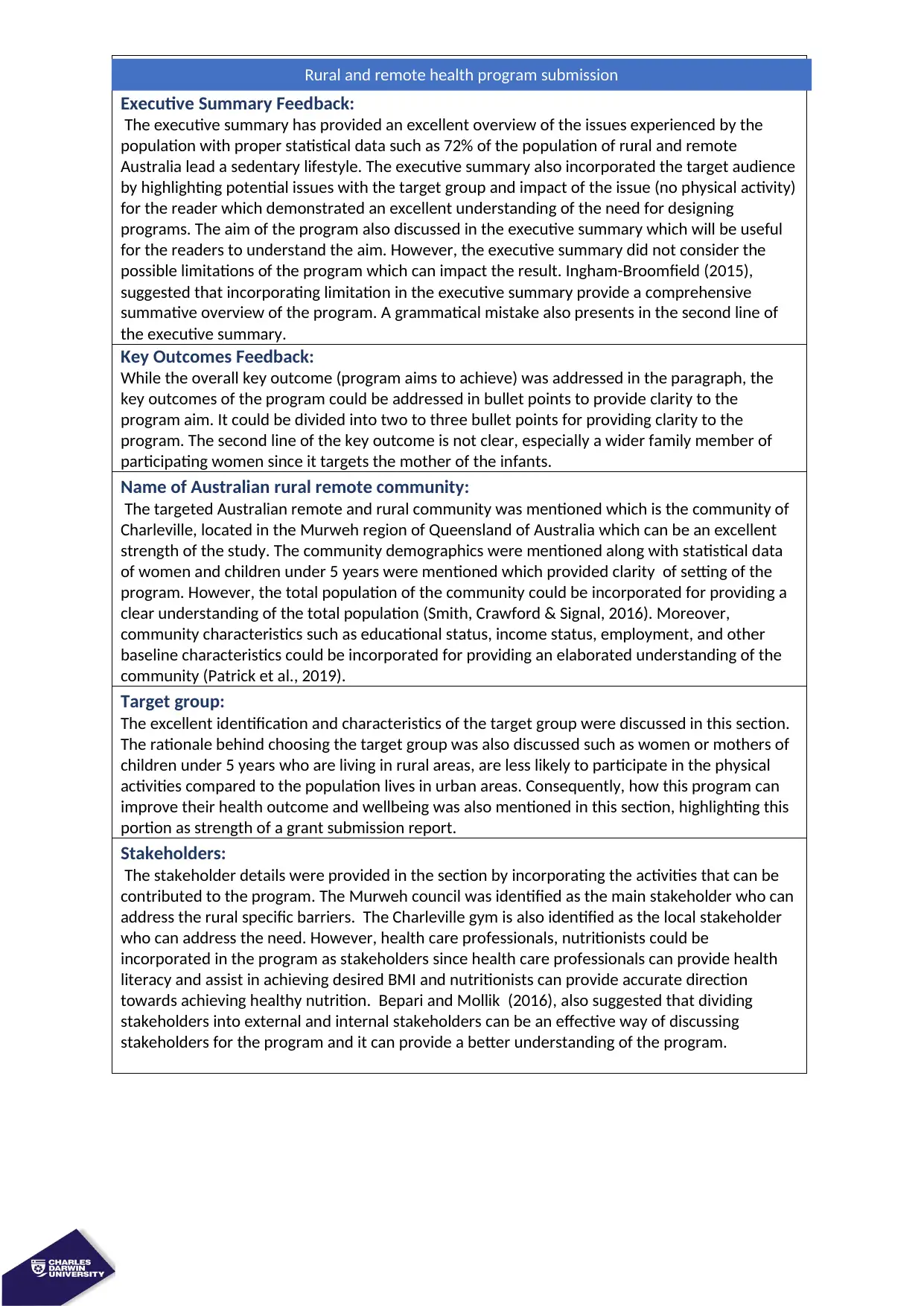
Executive Summary Feedback:
The executive summary has provided an excellent overview of the issues experienced by the
population with proper statistical data such as 72% of the population of rural and remote
Australia lead a sedentary lifestyle. The executive summary also incorporated the target audience
by highlighting potential issues with the target group and impact of the issue (no physical activity)
for the reader which demonstrated an excellent understanding of the need for designing
programs. The aim of the program also discussed in the executive summary which will be useful
for the readers to understand the aim. However, the executive summary did not consider the
possible limitations of the program which can impact the result. Ingham-Broomfield (2015),
suggested that incorporating limitation in the executive summary provide a comprehensive
summative overview of the program. A grammatical mistake also presents in the second line of
the executive summary.
Key Outcomes Feedback:
While the overall key outcome (program aims to achieve) was addressed in the paragraph, the
key outcomes of the program could be addressed in bullet points to provide clarity to the
program aim. It could be divided into two to three bullet points for providing clarity to the
program. The second line of the key outcome is not clear, especially a wider family member of
participating women since it targets the mother of the infants.
Name of Australian rural remote community:
The targeted Australian remote and rural community was mentioned which is the community of
Charleville, located in the Murweh region of Queensland of Australia which can be an excellent
strength of the study. The community demographics were mentioned along with statistical data
of women and children under 5 years were mentioned which provided clarity of setting of the
program. However, the total population of the community could be incorporated for providing a
clear understanding of the total population (Smith, Crawford & Signal, 2016). Moreover,
community characteristics such as educational status, income status, employment, and other
baseline characteristics could be incorporated for providing an elaborated understanding of the
community (Patrick et al., 2019).
Target group:
The excellent identification and characteristics of the target group were discussed in this section.
The rationale behind choosing the target group was also discussed such as women or mothers of
children under 5 years who are living in rural areas, are less likely to participate in the physical
activities compared to the population lives in urban areas. Consequently, how this program can
improve their health outcome and wellbeing was also mentioned in this section, highlighting this
portion as strength of a grant submission report.
Stakeholders:
The stakeholder details were provided in the section by incorporating the activities that can be
contributed to the program. The Murweh council was identified as the main stakeholder who can
address the rural specific barriers. The Charleville gym is also identified as the local stakeholder
who can address the need. However, health care professionals, nutritionists could be
incorporated in the program as stakeholders since health care professionals can provide health
literacy and assist in achieving desired BMI and nutritionists can provide accurate direction
towards achieving healthy nutrition. Bepari and Mollik (2016), also suggested that dividing
stakeholders into external and internal stakeholders can be an effective way of discussing
stakeholders for the program and it can provide a better understanding of the program.
Rural and remote health program submission
The executive summary has provided an excellent overview of the issues experienced by the
population with proper statistical data such as 72% of the population of rural and remote
Australia lead a sedentary lifestyle. The executive summary also incorporated the target audience
by highlighting potential issues with the target group and impact of the issue (no physical activity)
for the reader which demonstrated an excellent understanding of the need for designing
programs. The aim of the program also discussed in the executive summary which will be useful
for the readers to understand the aim. However, the executive summary did not consider the
possible limitations of the program which can impact the result. Ingham-Broomfield (2015),
suggested that incorporating limitation in the executive summary provide a comprehensive
summative overview of the program. A grammatical mistake also presents in the second line of
the executive summary.
Key Outcomes Feedback:
While the overall key outcome (program aims to achieve) was addressed in the paragraph, the
key outcomes of the program could be addressed in bullet points to provide clarity to the
program aim. It could be divided into two to three bullet points for providing clarity to the
program. The second line of the key outcome is not clear, especially a wider family member of
participating women since it targets the mother of the infants.
Name of Australian rural remote community:
The targeted Australian remote and rural community was mentioned which is the community of
Charleville, located in the Murweh region of Queensland of Australia which can be an excellent
strength of the study. The community demographics were mentioned along with statistical data
of women and children under 5 years were mentioned which provided clarity of setting of the
program. However, the total population of the community could be incorporated for providing a
clear understanding of the total population (Smith, Crawford & Signal, 2016). Moreover,
community characteristics such as educational status, income status, employment, and other
baseline characteristics could be incorporated for providing an elaborated understanding of the
community (Patrick et al., 2019).
Target group:
The excellent identification and characteristics of the target group were discussed in this section.
The rationale behind choosing the target group was also discussed such as women or mothers of
children under 5 years who are living in rural areas, are less likely to participate in the physical
activities compared to the population lives in urban areas. Consequently, how this program can
improve their health outcome and wellbeing was also mentioned in this section, highlighting this
portion as strength of a grant submission report.
Stakeholders:
The stakeholder details were provided in the section by incorporating the activities that can be
contributed to the program. The Murweh council was identified as the main stakeholder who can
address the rural specific barriers. The Charleville gym is also identified as the local stakeholder
who can address the need. However, health care professionals, nutritionists could be
incorporated in the program as stakeholders since health care professionals can provide health
literacy and assist in achieving desired BMI and nutritionists can provide accurate direction
towards achieving healthy nutrition. Bepari and Mollik (2016), also suggested that dividing
stakeholders into external and internal stakeholders can be an effective way of discussing
stakeholders for the program and it can provide a better understanding of the program.
Rural and remote health program submission
⊘ This is a preview!⊘
Do you want full access?
Subscribe today to unlock all pages.

Trusted by 1+ million students worldwide
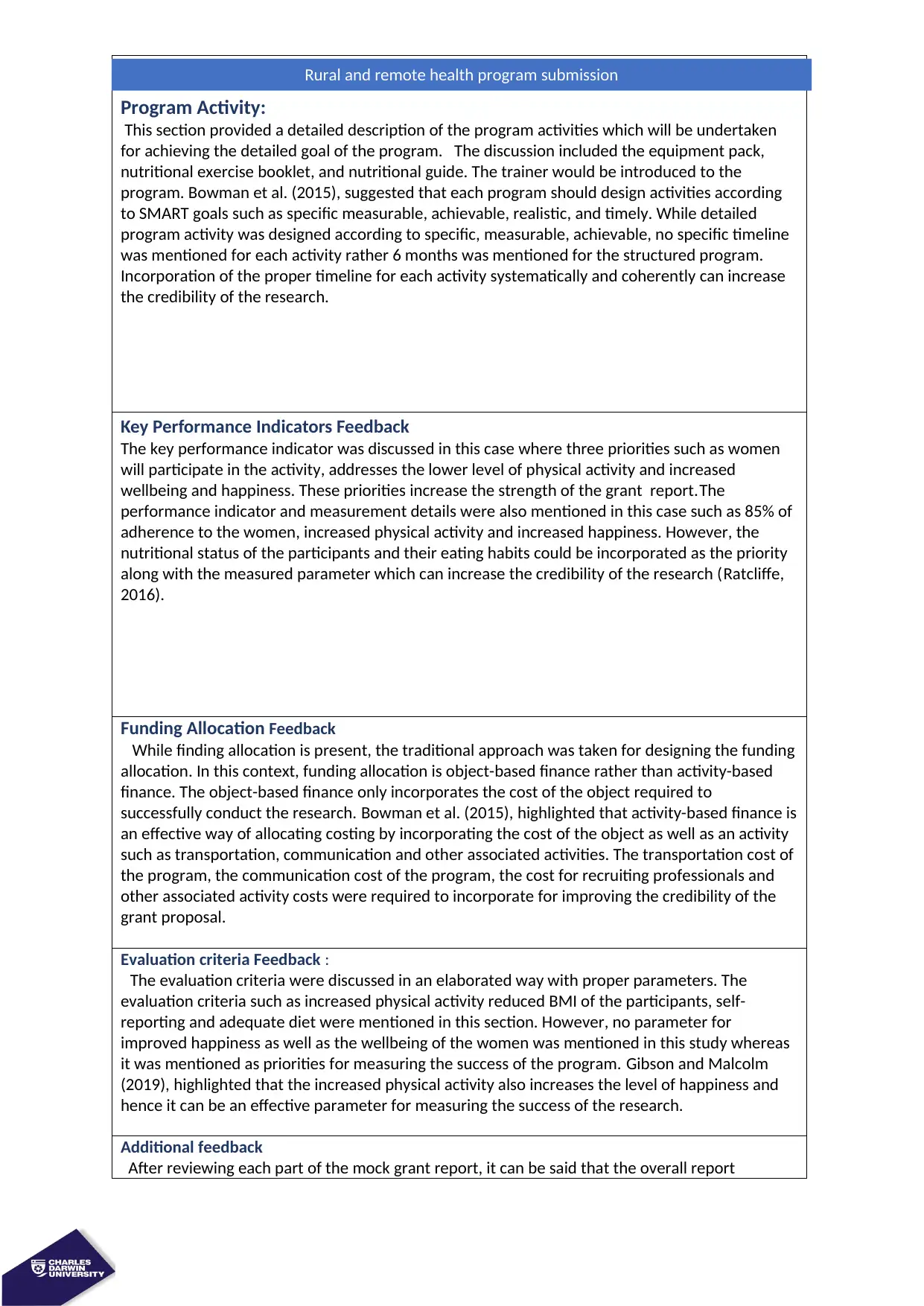
Program Activity:
This section provided a detailed description of the program activities which will be undertaken
for achieving the detailed goal of the program. The discussion included the equipment pack,
nutritional exercise booklet, and nutritional guide. The trainer would be introduced to the
program. Bowman et al. (2015), suggested that each program should design activities according
to SMART goals such as specific measurable, achievable, realistic, and timely. While detailed
program activity was designed according to specific, measurable, achievable, no specific timeline
was mentioned for each activity rather 6 months was mentioned for the structured program.
Incorporation of the proper timeline for each activity systematically and coherently can increase
the credibility of the research.
Key Performance Indicators Feedback
The key performance indicator was discussed in this case where three priorities such as women
will participate in the activity, addresses the lower level of physical activity and increased
wellbeing and happiness. These priorities increase the strength of the grant report.The
performance indicator and measurement details were also mentioned in this case such as 85% of
adherence to the women, increased physical activity and increased happiness. However, the
nutritional status of the participants and their eating habits could be incorporated as the priority
along with the measured parameter which can increase the credibility of the research (Ratcliffe,
2016).
Funding Allocation Feedback
While finding allocation is present, the traditional approach was taken for designing the funding
allocation. In this context, funding allocation is object-based finance rather than activity-based
finance. The object-based finance only incorporates the cost of the object required to
successfully conduct the research. Bowman et al. (2015), highlighted that activity-based finance is
an effective way of allocating costing by incorporating the cost of the object as well as an activity
such as transportation, communication and other associated activities. The transportation cost of
the program, the communication cost of the program, the cost for recruiting professionals and
other associated activity costs were required to incorporate for improving the credibility of the
grant proposal.
Evaluation criteria Feedback :
The evaluation criteria were discussed in an elaborated way with proper parameters. The
evaluation criteria such as increased physical activity reduced BMI of the participants, self-
reporting and adequate diet were mentioned in this section. However, no parameter for
improved happiness as well as the wellbeing of the women was mentioned in this study whereas
it was mentioned as priorities for measuring the success of the program. Gibson and Malcolm
(2019), highlighted that the increased physical activity also increases the level of happiness and
hence it can be an effective parameter for measuring the success of the research.
Additional feedback
After reviewing each part of the mock grant report, it can be said that the overall report
Rural and remote health program submission
This section provided a detailed description of the program activities which will be undertaken
for achieving the detailed goal of the program. The discussion included the equipment pack,
nutritional exercise booklet, and nutritional guide. The trainer would be introduced to the
program. Bowman et al. (2015), suggested that each program should design activities according
to SMART goals such as specific measurable, achievable, realistic, and timely. While detailed
program activity was designed according to specific, measurable, achievable, no specific timeline
was mentioned for each activity rather 6 months was mentioned for the structured program.
Incorporation of the proper timeline for each activity systematically and coherently can increase
the credibility of the research.
Key Performance Indicators Feedback
The key performance indicator was discussed in this case where three priorities such as women
will participate in the activity, addresses the lower level of physical activity and increased
wellbeing and happiness. These priorities increase the strength of the grant report.The
performance indicator and measurement details were also mentioned in this case such as 85% of
adherence to the women, increased physical activity and increased happiness. However, the
nutritional status of the participants and their eating habits could be incorporated as the priority
along with the measured parameter which can increase the credibility of the research (Ratcliffe,
2016).
Funding Allocation Feedback
While finding allocation is present, the traditional approach was taken for designing the funding
allocation. In this context, funding allocation is object-based finance rather than activity-based
finance. The object-based finance only incorporates the cost of the object required to
successfully conduct the research. Bowman et al. (2015), highlighted that activity-based finance is
an effective way of allocating costing by incorporating the cost of the object as well as an activity
such as transportation, communication and other associated activities. The transportation cost of
the program, the communication cost of the program, the cost for recruiting professionals and
other associated activity costs were required to incorporate for improving the credibility of the
grant proposal.
Evaluation criteria Feedback :
The evaluation criteria were discussed in an elaborated way with proper parameters. The
evaluation criteria such as increased physical activity reduced BMI of the participants, self-
reporting and adequate diet were mentioned in this section. However, no parameter for
improved happiness as well as the wellbeing of the women was mentioned in this study whereas
it was mentioned as priorities for measuring the success of the program. Gibson and Malcolm
(2019), highlighted that the increased physical activity also increases the level of happiness and
hence it can be an effective parameter for measuring the success of the research.
Additional feedback
After reviewing each part of the mock grant report, it can be said that the overall report
Rural and remote health program submission
Paraphrase This Document
Need a fresh take? Get an instant paraphrase of this document with our AI Paraphraser
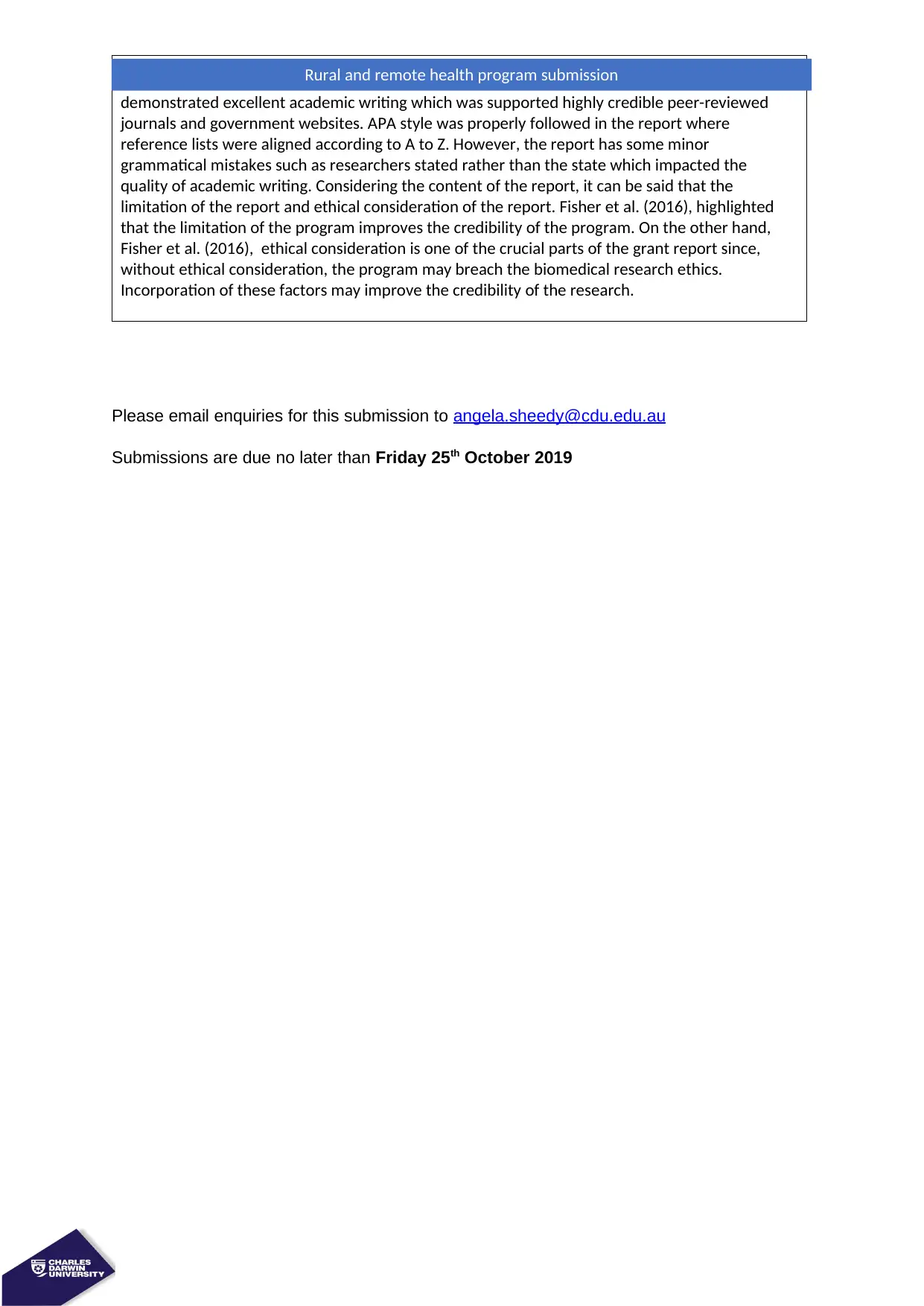
demonstrated excellent academic writing which was supported highly credible peer-reviewed
journals and government websites. APA style was properly followed in the report where
reference lists were aligned according to A to Z. However, the report has some minor
grammatical mistakes such as researchers stated rather than the state which impacted the
quality of academic writing. Considering the content of the report, it can be said that the
limitation of the report and ethical consideration of the report. Fisher et al. (2016), highlighted
that the limitation of the program improves the credibility of the program. On the other hand,
Fisher et al. (2016), ethical consideration is one of the crucial parts of the grant report since,
without ethical consideration, the program may breach the biomedical research ethics.
Incorporation of these factors may improve the credibility of the research.
Please email enquiries for this submission to angela.sheedy@cdu.edu.au
Submissions are due no later than Friday 25th October 2019
Rural and remote health program submission
journals and government websites. APA style was properly followed in the report where
reference lists were aligned according to A to Z. However, the report has some minor
grammatical mistakes such as researchers stated rather than the state which impacted the
quality of academic writing. Considering the content of the report, it can be said that the
limitation of the report and ethical consideration of the report. Fisher et al. (2016), highlighted
that the limitation of the program improves the credibility of the program. On the other hand,
Fisher et al. (2016), ethical consideration is one of the crucial parts of the grant report since,
without ethical consideration, the program may breach the biomedical research ethics.
Incorporation of these factors may improve the credibility of the research.
Please email enquiries for this submission to angela.sheedy@cdu.edu.au
Submissions are due no later than Friday 25th October 2019
Rural and remote health program submission
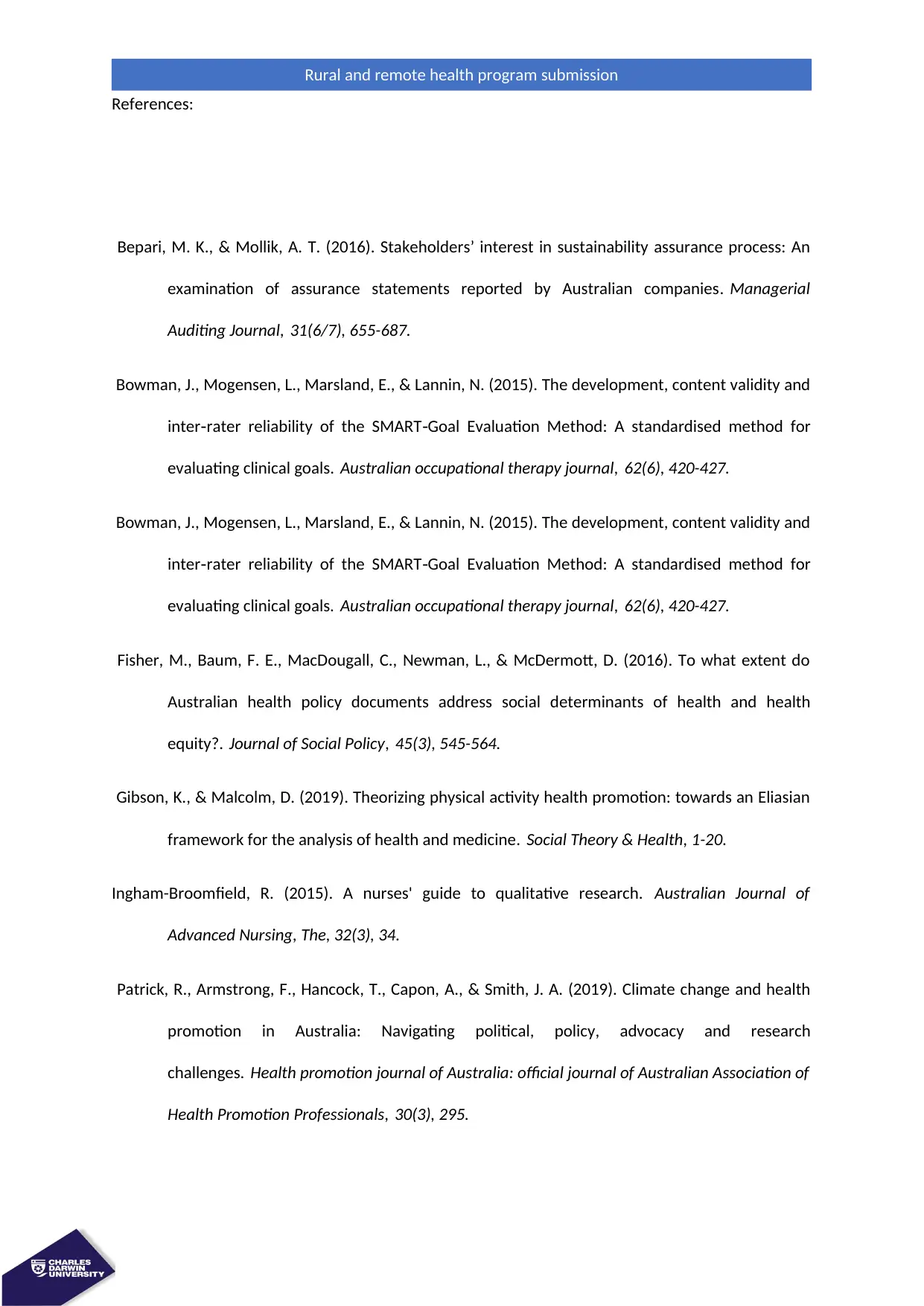
References:
Bepari, M. K., & Mollik, A. T. (2016). Stakeholders’ interest in sustainability assurance process: An
examination of assurance statements reported by Australian companies. Managerial
Auditing Journal, 31(6/7), 655-687.
Bowman, J., Mogensen, L., Marsland, E., & Lannin, N. (2015). The development, content validity and
inter rater reliability of the SMART Goal Evaluation Method: A standardised method for‐ ‐
evaluating clinical goals. Australian occupational therapy journal, 62(6), 420-427.
Bowman, J., Mogensen, L., Marsland, E., & Lannin, N. (2015). The development, content validity and
inter rater reliability of the SMART Goal Evaluation Method: A standardised method for‐ ‐
evaluating clinical goals. Australian occupational therapy journal, 62(6), 420-427.
Fisher, M., Baum, F. E., MacDougall, C., Newman, L., & McDermott, D. (2016). To what extent do
Australian health policy documents address social determinants of health and health
equity?. Journal of Social Policy, 45(3), 545-564.
Gibson, K., & Malcolm, D. (2019). Theorizing physical activity health promotion: towards an Eliasian
framework for the analysis of health and medicine. Social Theory & Health, 1-20.
Ingham-Broomfield, R. (2015). A nurses' guide to qualitative research. Australian Journal of
Advanced Nursing, The, 32(3), 34.
Patrick, R., Armstrong, F., Hancock, T., Capon, A., & Smith, J. A. (2019). Climate change and health
promotion in Australia: Navigating political, policy, advocacy and research
challenges. Health promotion journal of Australia: official journal of Australian Association of
Health Promotion Professionals, 30(3), 295.
Rural and remote health program submission
Bepari, M. K., & Mollik, A. T. (2016). Stakeholders’ interest in sustainability assurance process: An
examination of assurance statements reported by Australian companies. Managerial
Auditing Journal, 31(6/7), 655-687.
Bowman, J., Mogensen, L., Marsland, E., & Lannin, N. (2015). The development, content validity and
inter rater reliability of the SMART Goal Evaluation Method: A standardised method for‐ ‐
evaluating clinical goals. Australian occupational therapy journal, 62(6), 420-427.
Bowman, J., Mogensen, L., Marsland, E., & Lannin, N. (2015). The development, content validity and
inter rater reliability of the SMART Goal Evaluation Method: A standardised method for‐ ‐
evaluating clinical goals. Australian occupational therapy journal, 62(6), 420-427.
Fisher, M., Baum, F. E., MacDougall, C., Newman, L., & McDermott, D. (2016). To what extent do
Australian health policy documents address social determinants of health and health
equity?. Journal of Social Policy, 45(3), 545-564.
Gibson, K., & Malcolm, D. (2019). Theorizing physical activity health promotion: towards an Eliasian
framework for the analysis of health and medicine. Social Theory & Health, 1-20.
Ingham-Broomfield, R. (2015). A nurses' guide to qualitative research. Australian Journal of
Advanced Nursing, The, 32(3), 34.
Patrick, R., Armstrong, F., Hancock, T., Capon, A., & Smith, J. A. (2019). Climate change and health
promotion in Australia: Navigating political, policy, advocacy and research
challenges. Health promotion journal of Australia: official journal of Australian Association of
Health Promotion Professionals, 30(3), 295.
Rural and remote health program submission
⊘ This is a preview!⊘
Do you want full access?
Subscribe today to unlock all pages.

Trusted by 1+ million students worldwide
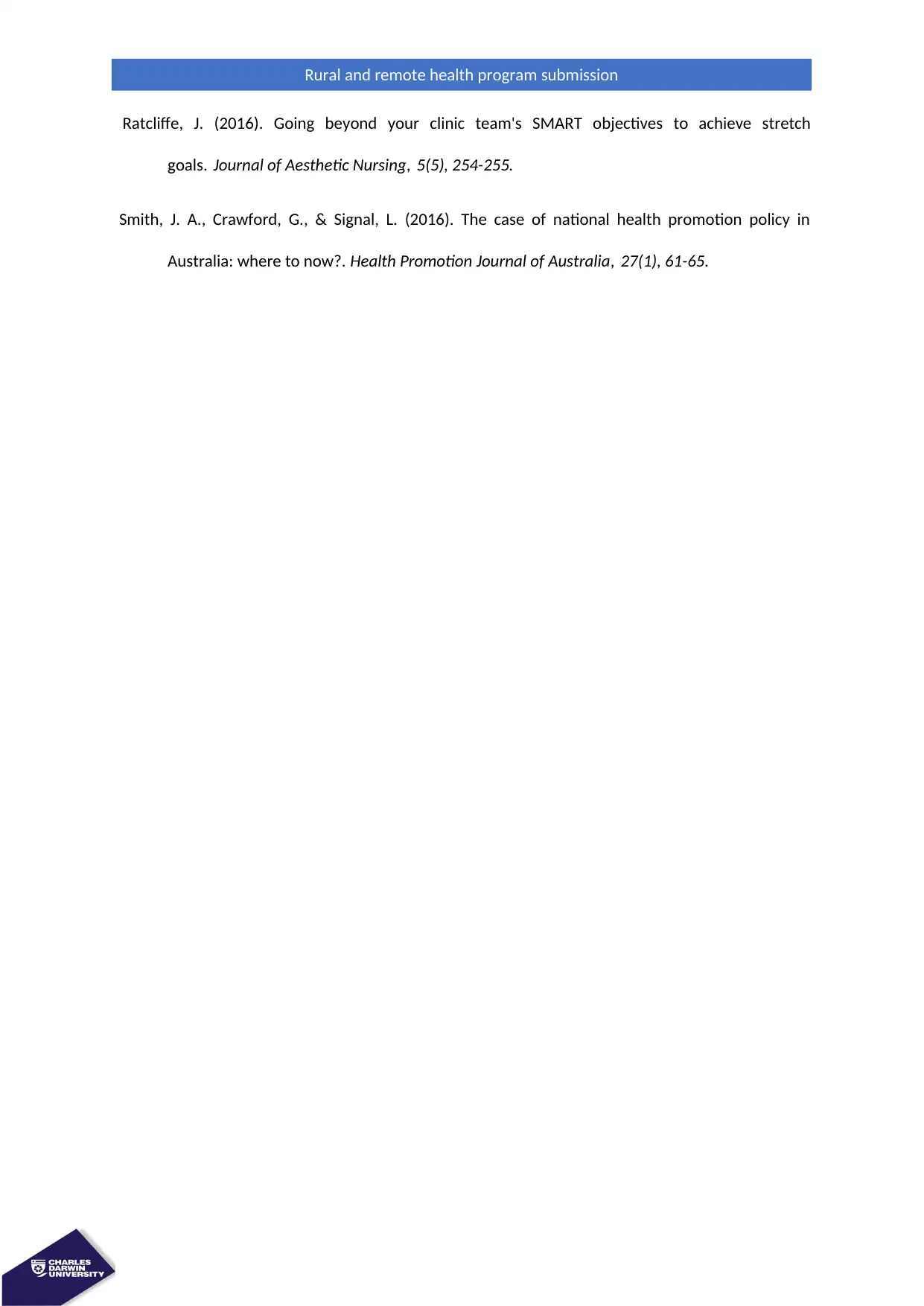
Ratcliffe, J. (2016). Going beyond your clinic team's SMART objectives to achieve stretch
goals. Journal of Aesthetic Nursing, 5(5), 254-255.
Smith, J. A., Crawford, G., & Signal, L. (2016). The case of national health promotion policy in
Australia: where to now?. Health Promotion Journal of Australia, 27(1), 61-65.
Rural and remote health program submission
goals. Journal of Aesthetic Nursing, 5(5), 254-255.
Smith, J. A., Crawford, G., & Signal, L. (2016). The case of national health promotion policy in
Australia: where to now?. Health Promotion Journal of Australia, 27(1), 61-65.
Rural and remote health program submission
1 out of 7
Related Documents
Your All-in-One AI-Powered Toolkit for Academic Success.
+13062052269
info@desklib.com
Available 24*7 on WhatsApp / Email
![[object Object]](/_next/static/media/star-bottom.7253800d.svg)
Unlock your academic potential
Copyright © 2020–2025 A2Z Services. All Rights Reserved. Developed and managed by ZUCOL.




